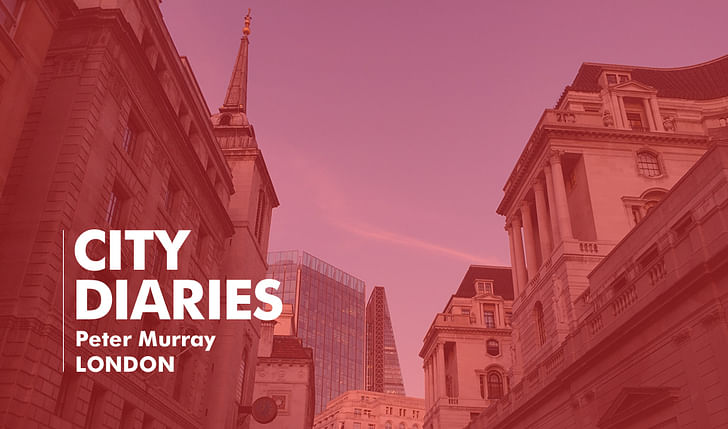

"The analysis showed that London's architecture sector produced a massive £1.7 billion in gross value added (GVA)—38 per cent bigger than the product, graphic and fashion design sectors put together and greater than many observers expected."
As British Prime Minister Theresa May prepared to officially launched negotiations with the European Union over Brexit, 20,000 or so property professionals including 2000 architects gathered in Cannes for the annual MIPIM real estate jamboree. London Deputy Mayors reiterated the message from City Hall that 'London is open' and the mood of the Brits was upbeat in spite of the expectations of a bumpy ride for the industry over the next couple of years. For the first time ever the British Government sent a delegation to the event to network with existing markets and find new ones, as the shape of the country's economy dramatically changes. Mrs May and her team fully realise the need to refocus the economy and in January this year reprised the "Britain is Great" campaign to encourage Britain's companies to become more outward facing and export more.
So it was timely that the London Festival of Architecture launched a report at the fair, carried out by GreaterLondon Authority's economics team, into the scale of the contribution made by architectural services to the capital's economy in terms of jobs, value added, education and international competitiveness. The analysis showed that London's architecture sector produced a massive £1.7 billion in gross value added (GVA) - 38 per cent bigger than the product, graphic and fashion design sectors put together and greater than many observers expected. There are approximately 4,240 offices of various sizes employing some 22,800 people in London, a number that includes support staff as well as architects. The sector has grown by 7.6 per cent since 2009, faster than the creative industries and the London economy as a whole. One-in-four architect occupations in the UK are based in London, while approximately 40 per cent are female, more than double the rest of the country. Around one-third of the jobs in London’s architecture sector are taken by non-UK nationals in 2015. Of this, the majority (73.3 per cent) were from other parts of the EU.
The analysis showed that London's architecture sector produced a massive £1.7 billion in gross value added (GVA) - 38 per cent bigger than the product, graphic and fashion design sectors put together and greater than many observers expected.
The study also looked at the importance of London's historic fabric and reckoned that between £382.5 million and £453.9 million of London’s GVA could be attributed to architecture related tourism.
These are important figures, confirming London's key role as a global design and construction skills hub. This is a role that has blossomed for a number of reasons, some of which were the drivers of the City's preeminence in financial services: the appropriate geographic location and time zone, the English language, a trusted legal system and more flexible labour laws than other European centres. Then there is the wider network of world class professional expertise, engineers, project managers and cost consultants based in London that support the design teams. Add to that a reputation generated by the global presence of Rogers, Foster, Stirling, Hadid, Chipperfield et al and you have a powerful brand. But as the statistics show, this is a reputation that is also built on the imported skills from other European countries as well as other parts of the globe. These multi cultural offices, supported by an educational system that is also international in its intake, provide a level of diversity and a richness of thinking that is under threat from the tightening of the UK's borders. The appalling uncertainty to which EU nationals are condemned during the Brexit negotiations will surely damage the sector as they look elsewhere for employment.
I calculated that there were more architects per square metre in Clerkenwell than anywhere else in the world.
Londoners did not vote for Brexit and Mayor Khan's London is Open campaign is attempting to modify the impact Brexit will have on London. The irony is that capital's economy is so vital to the rest of the UK that it's diminution will impact hardest on those areas that voted to leave, which raises interesting issues with regard to the divide between the larger metropolitan areas who are linked into and have benefitted from the global economy and the second tier cities and rural economies that feel excluded. There was much talk at MIPIM of building better networks between cities with a particular focus on the Paris-London axis driven by the positive relationship between Mayors Khan and Hidalgo.
I started the London Festival of Architecture in 2004 based in the creative Clerkenwell area of the city. I calculated that there were more architects per square metre in Clerkenwell than anywhere else in the world. It made a good headline but lacked the convincing evidence of these latest GLA figures. Now it is important that the politicians protect this major contribution to the London and UK economy as they negotiate our exit from Europe and that the profession gives its full backing to the Festival to provide real evidence of architects' and architecture's cultural impact on the capital.
I am fascinated by cities in general and London in particular - its history, its architecture, the way it works, its planning, development, and how it is, in Rasmussen's title, a unique city. London is a much better place than it was when I arrived half a century ago and I want to do my bit to ...
No Comments
Block this user
Are you sure you want to block this user and hide all related comments throughout the site?
Archinect
This is your first comment on Archinect. Your comment will be visible once approved.